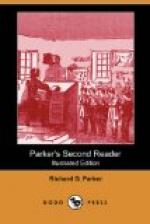14. Before they heard the question, they looked very sober, and thought their master intended to puzzle them, or to give them a long sentence to commit to memory. But as soon as they heard the question, they began to smile among themselves, and wonder how their teacher should call that a hard question.
15. A dozen hands were immediately raised, to signify that so many of the children were ready to answer it.
16. Well, John, said the teacher, your hand is up; can you tell me what a bird is?
17. John immediately rose, and standing on the right-hand side of his seat, said, A bird is a thing that has two legs.
18. Well, said the teacher, suppose some one should saw off two of the legs of my chair; it would then be a thing that has two legs; but it would not be a bird, would it? You see, then, that your answer is not correct.
19. I will not mention the names of the other children who raised their hands; but I will tell you what the answers were which some of them made to the questions, and what the teacher said about each of their answers.
20. One of the children said that a bird is an animal with two legs. But, said the teacher, all little boys and girls, and all men and women, are animals with two legs; but they are not birds.
21. Another child said that a bird is an animal that has wings. But the teacher said there are some fishes that have wings, and that fishes are not birds.
22. A bright little girl then modestly rose and said, A bird is an animal that has legs and wings, and that flies. The teacher smiled upon her very kindly, and told her that it is true that a bird has legs and wings, and that it flies; but, said he, there is another animal, also, that has legs and wings, and that flies very fast in the air. It is called a bat. It flies only in the night; but it has no feathers, and therefore is not a bird.
23. Upon hearing this, another bright-eyed child very timidly rose and said, A bird is an animal that has legs, wings and feathers. Very well, said the teacher; but can you not think of anything else that a bird has, which other creatures have not?
24. The children looked at one another, wondering what their teacher could mean; and no one could think what to say, until the teacher said to them, Think a moment, and try to tell me how a bird’s mouth looks. Look first at my mouth. You see I have two lips, and these two lips form my mouth. Now, tell me whether a bird has two lips; and if he has not, what he has instead of lips.
25. One of the children immediately arose and said, that a bird has no lips, but he has a bill; and that bill opens as the lips of a man do, and forms the mouth of the bird.
26. Yes, said the teacher; and now listen to me while I tell you the things you should always mention, when you are asked what a bird is,—
First, A bird is an animal.
Secondly, It has two legs.
Thirdly, It has two wings.
Fourthly, It has feathers.
Fifthly, It has a hard, glossy
bill.




